Ljubljana related
STA, 15 August 2019 - Thousands of Catholic pilgrims have gathered at religious shrines devoted to the Virgin Mary across Slovenia to celebrate her assumption into heaven (on 14 August). The largest crowd converged on Brezje for mass celebrated by Archbishop of Ljubljana Stanislav Zore, who spoke about the meaning of hope in his sermon.
"Man needs hope more than the famished need bread, more than the thirsty need water ... Once we've given up hope, the selfish me goes wild, seeing only oneself and ones needs," the archbishop told more than 5,500 believers congregated outside the Basilica of Mary Help of Christians.
The church in the subalpine village of Brezje (NW) is Slovenia's most popular pilgrimage site. It was reportedly the scene of a miraculous healing 156 years ago and several more after that.
In his sermon, the archbishop thanked all of those who aspire to make Slovenia as society open to life and those who make the effort so that all children should have equal opportunities to develop their potential, especially in education.
"I'd like to thank you for demanding justice for all; to everyone putting in their effort to have the Constitutional Court decision on funding of private schools implemented," he said.
The court mandated in 2014 that private primary schools teaching nationally-approved curricula should be granted full rather than 85% government funding just like public schools. However, the parliament has still not implemented the ruling.
The pilgrims have come to Brezje from all over the country as well as from abroad and many more are still expected there later in the day. According to the head of the Brezje pilgrimage office, Andreja Eržen Firšt, the shrine attracts more than 10,000 people every year and their numbers keep increasing.
The number of pilgrims at Brezje has been building up in the days ahead of Assumption Day, many of whom have come on foot. Every year Roma families from around Slovenia come to Brezje at this time of year with their pastoral leader to spend some time in retreat there. This year more 350 have come.
Many Slovenian churches and other shrines are dedicated to Mary and holidays celebrating the virgin are popular among believers. As a result, Slovenian bishops entrusted the Slovenian nation into her hands in 1992. Since that year, Assumption Day has been observed as public holiday in Slovenia.
STA, 12 August 2019 - A central ceremony marking Eid al-Adha or the Festival of the Sacrifice, one of the biggest religious holidays in Islam, was held in Ljubljana's Kodeljevo Arena on Sunday. The ceremony was addressed by Mufti Nedžad Grabus, with the start of prayers scheduled for 6.36am.
The Muslim holiday provides an opportunity for believers to embark on a self-reflection journey and consider righting the wrongs they might have done to themselves or others, said the Muslim community in Slovenia.
The believers should be aware how unpredictable and ephemeral life is, given that everything is transient, it added.
The Festival of the Sacrifice is the time for atonement and asking for forgiveness, but also the time for sharing joy with loved ones.
The Eid al-Adha celebrations start with pilgrims setting out on trips to Mecca and Medina.
The highlight of the annual pilgrimage, which took place on Saturday, is held on Mount Arafat, a hill east of Mecca in the plain of Arafat, where pilgrims gather to pray in unity which defies any class, political or social divides.
This year, 28 Muslims from Slovenia have embarked on the journey to Mecca. Those who are not part of the pilgrimage celebrate the holiday with their families.
Apart from Ljubljana, Eid al-Adha prayers will be held in other Slovenian cities and towns with Muslim communities as well.
Next year's Eid al-Adha celebrations are expected to take place in the Ljubljana mosque instead of the Kodeljevo sports arena since the construction of the former is all but completed.
All our stories on Islam in Slovenia are here
July 7, 2019
You might not have heard of the Trans-Universal Zombie Church of Blissful Ringing yet, but this growing religion is currently the fifth biggest belief system in Slovenia.
The church was formed in 2013 in close relation to the 2012-13 anti-government protests. Originally the Church of Blissful Ringing added “zombie” to its name after the then ruling SDS of Janez Janša labelled the protesters as zombies in its Tweets.
In 2014 this indigenous Slovenian church was registered with the Office for Religious Communities of the Ministry of Culture under the number of order 46.
It currently has around 12,000 members, which makes it the fifth most popular religion in Slovenia, after the Roman Catholic Church, Islam, Christian Orthodox and Lutheran Church. It’s worth mentioning, however, that the current numbers of the other four religions date from the year 2002. After that the Government Statistics Office switched to a much cheaper register-based census (2011), which no longer provides data on citizens’ religious affiliation or ethnicity.
Since its inception the Church mostly operates democratically via its Facebook page. Its holy book was published in October 2014.
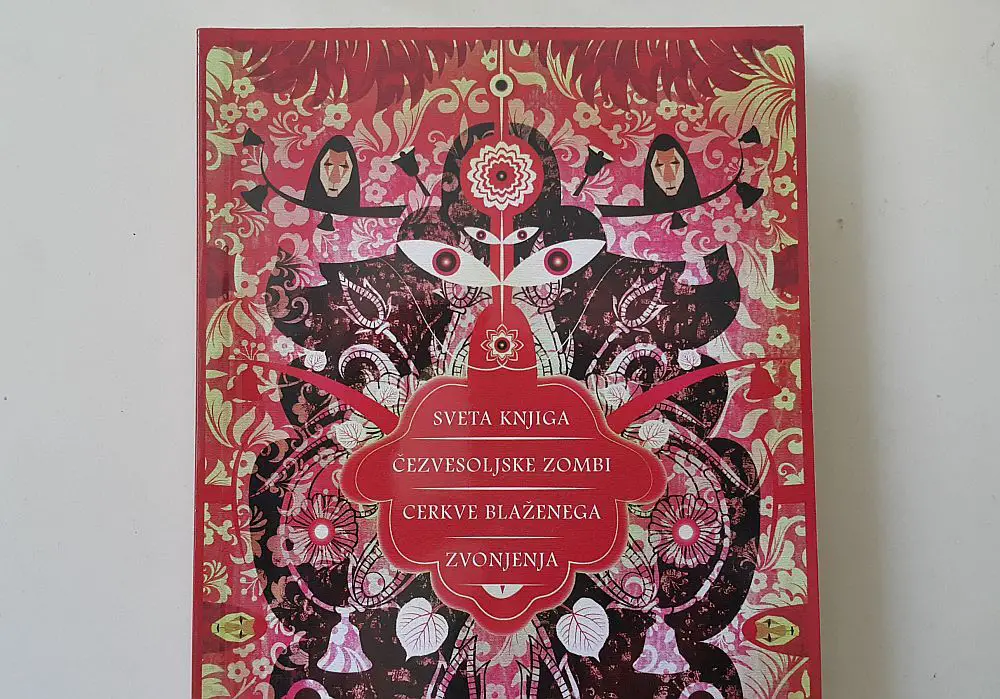
A compendium of articles, dogmas, gospels, revelations and other truths explains what the Church is all about and also forms the basis for theological contemplation of its followers.
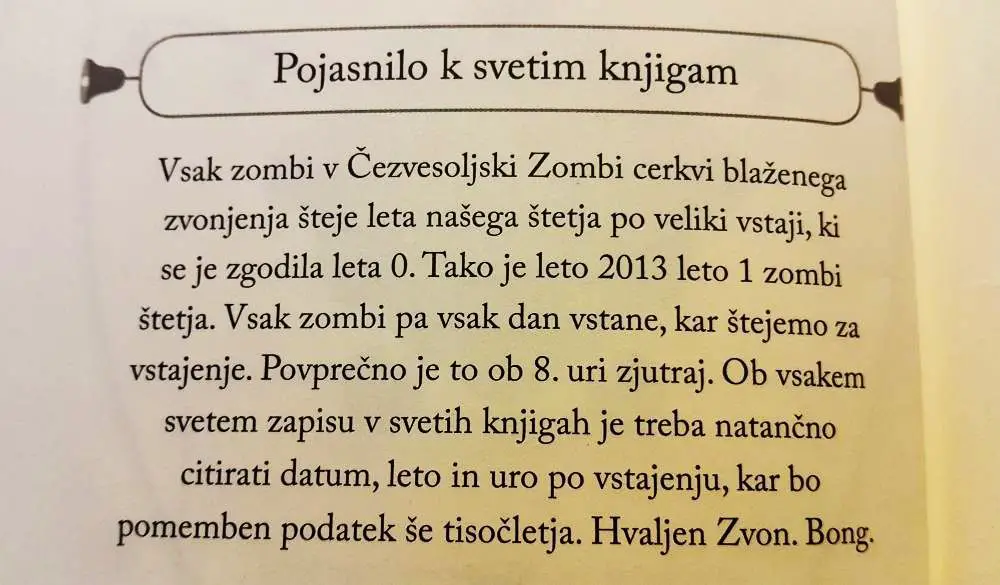
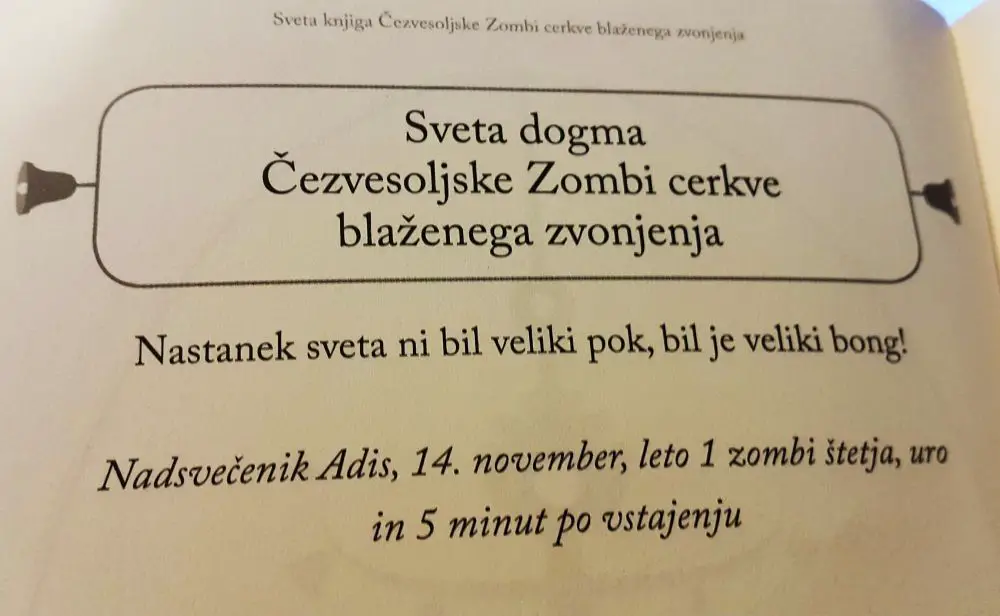
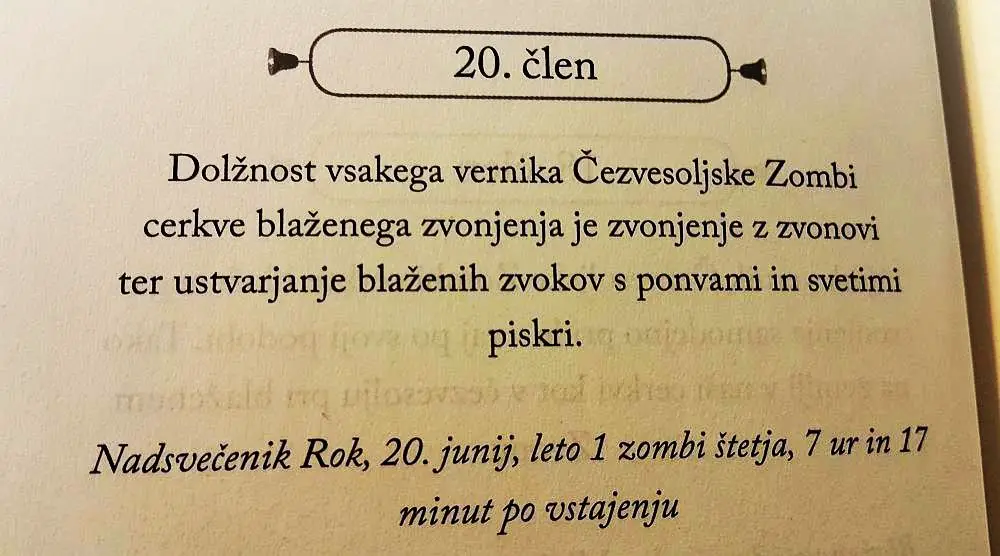
Translation: Article 20; Every Trans-universal Zombie Church of the Blissful Ringing believer’s duty is ringing bells and creating blissful sounds with pans and holy pots. (Archpriest Rok, June 20, Zombie Year 1, 7 hours and 17 minutes after the resurrection)
But is there an afterlife? The church believes there is.
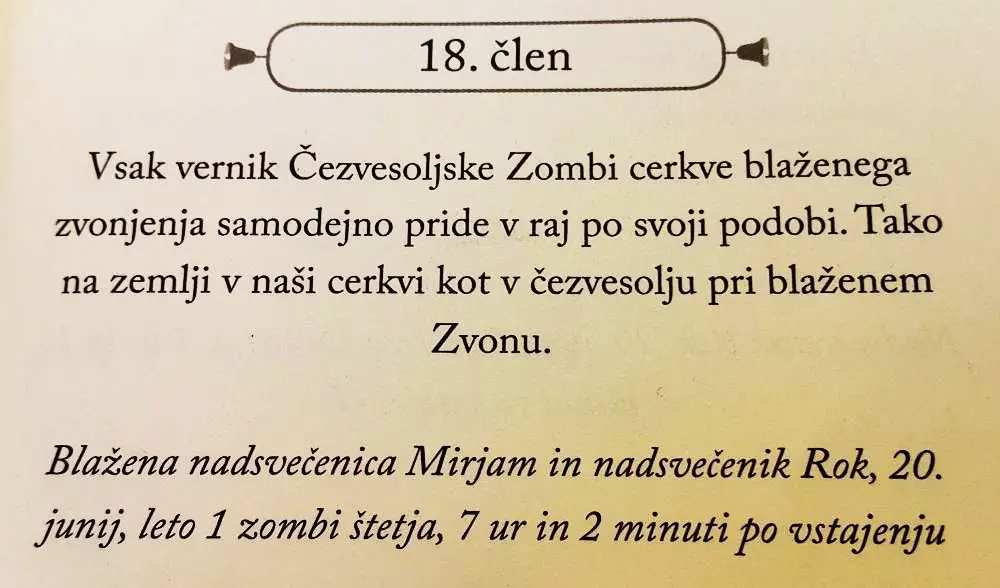
It was later explained that going to “Heaven in their own image” means that Heaven is what each of the undead considers it to be. If for someone Heaven is a Rammstein concert, that’s where they will end up after they die. Also, there is no Hell.
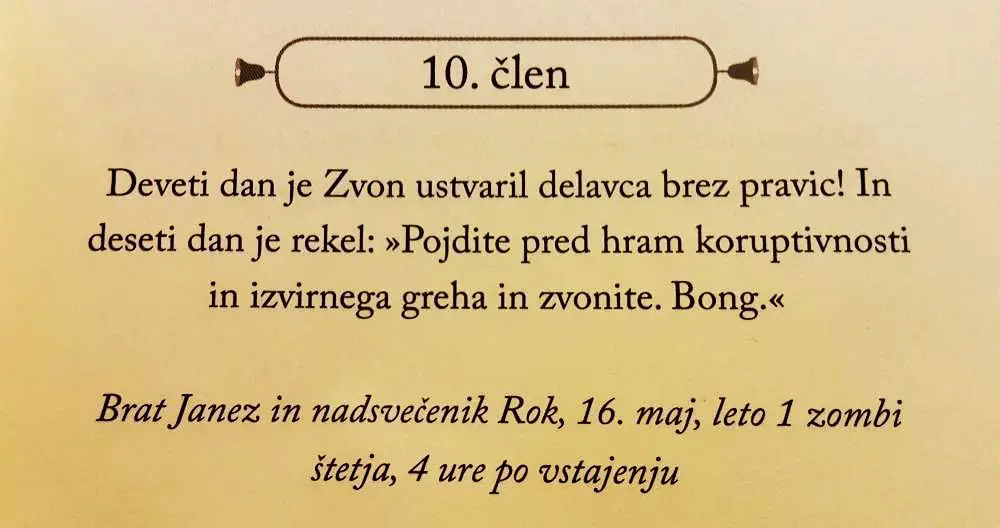
As it turns out, the Temple of Corruption and Original Sin actually means the National Assembly Building (i.e. Parliament). In the early years of its conception, the church held its holy mass in front of the Parliament building every Wednesday, while at the same time collecting donations in clothes and food for the Red Cross and Slovenian Association of Friends of Youth.
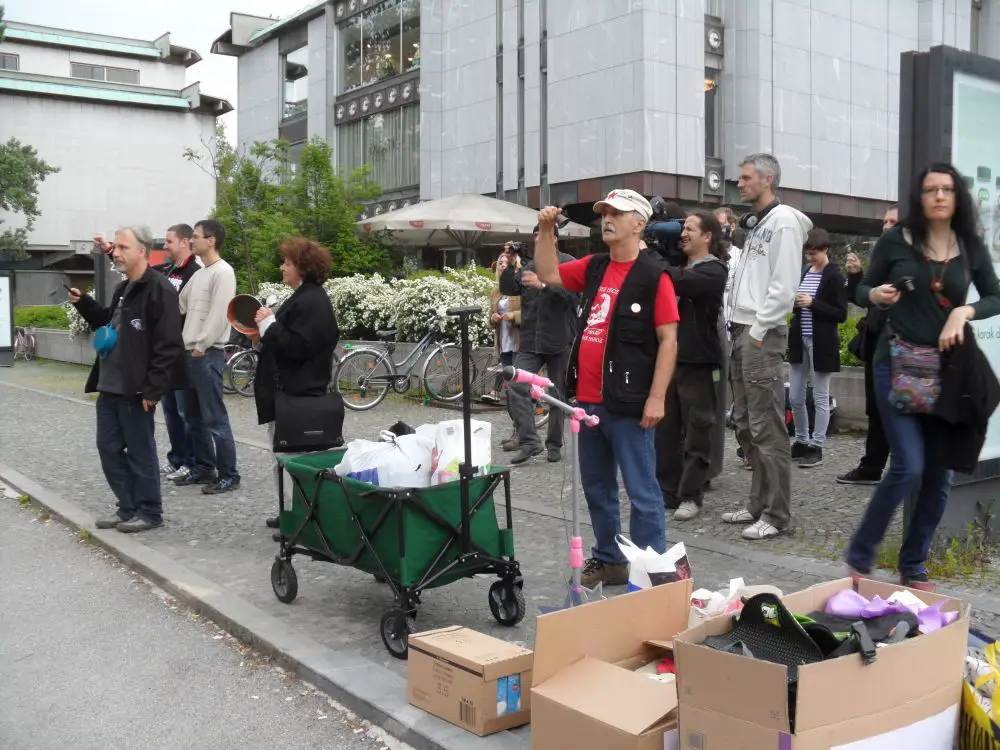
The new Church was met with a mixed response from the public.
A sociologist of religion Marjan Smrke, for example, stated for Delo, that the church is more of a parody of religion than a religion, but that such parodies are as old as religion itself, citing Roman Catholicism as a parody of original Christianity as an example. According to Smrke, the Zombie Church belongs to a new generation of parody religions, such as Pastafarianism and Jediism.
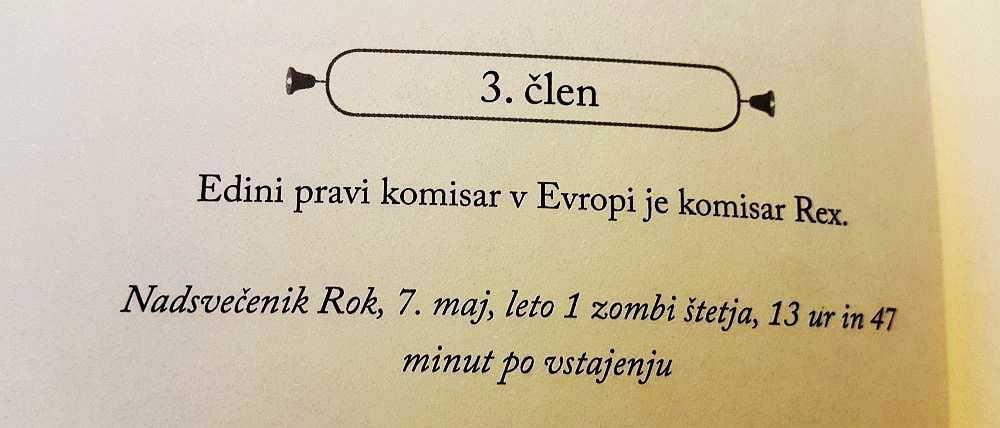
The Ministry also received a protest letter from the Catholic Institute for Family and Culture of Life (KUL), who expressed offence at the Ministry’s decision to register the Church, claiming that the Zombie Church was in fact a “nonreligious” community. KUL saw the recognition given to the Church as part of the Minister Uroš Grilc’ broader “Christianophobic” plot: “In accordance with the secular doctrine of a hateful attitude towards religious communities, with the aforementioned registration the Minister encourages public mockery of religious communities and the spread of prejudices against religion and religiousness in general.”
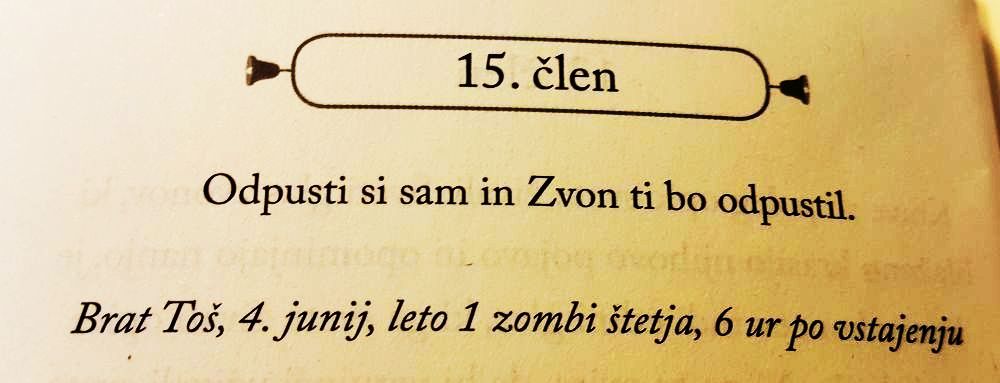
Gregor Lesjak, the director of the Office for Religious Communities, also replied to KUL’s complains that a joke religion was added to the list of the true religious communities. In an article by Delo, Lesjak was quoted emphasizing that the Zombie Church met all of the required criteria and explained that the law does not call for verifications of “religiousness”.
The problematisation of religiousness with the emerging new religious communities rests, according to Lesjak, on three misconceptions. The first misconception is a belief that the State is a guardian of the sacred: “The State is not the guardian of the sacred, religious communities are.” Secondly, the registration does not mean that the state issues a certificate indicating that the group’s religious teachings are genuine, appropriate or true. Gaining and keeping the trust of their followers is something that rests with the religious institutions themselves. And thirdly, it is not State’s task to tell its citizens what kind of things are good or bad to do, like a mother would tell their child. The State offers its citizens various legal forms of organisation under equal terms. If it turns out that a group of citizens has chosen a form of organisation that hindered the development of their own plans, the responsibility for that rests entirely with the group, not the State.
In an interview for MMC, Rok Gros, Archpriest of the Zombie Church and the Keeper of the Pot and Pan, didn’t deny the similarity with the Pastafarianism, being quoted as saying “we don’t discriminate against anyone. Members of any other religion are welcome in our church, Pastafarians included.” However, he strongly denied that the Church was making fun of anyone, or that the Church was not a real one.
For Sobota info, Gros stated that “Calling us a parody is one of most serious insults to us. We are a very serious church.”
We too had some questions for the Church, specifically how many members does it currently have, whether it gets any public funding and whether it is true that the Church has managed to spread to Croatia. The Church replied with the following explanations.
Bell willing!
Our church has 12,000 members.
We do not receive any public funding, despite the fact that even the court decided that the Ministry of Health violated legislation by religious discrimination for not granting our pro bono clinic in Nova Gorica a status of humanitarian institution, the legal basis for bids on tenders.
In Croatia we have Archpriest Domagoj I the Lionheart, who takes care of spiritual needs of our believers in Croatia (marriages, holy masses…)
Best regards and Bell be with you.
Bong
Archpriest Rok, founder, Keeper of the Pot and Pan, July 1, 7 Zombie Year, 3 hours and 4 minutes after resurrection
For more on Trans-universal Zombie Church of Blissful Ringing, click here for its webpage, where you can also join.
STA, 27 June 2019 - An exhibition on famous Slovenian architect and designer Jože Plečnik (1872-1957) and his designs of sacred objects opened in the Vatican Museums on Thursday evening, featuring 33 selected liturgical vessels as well as video presentations of his sacred architectural works.
Related: Playful and Austere - A Visit to Plečnik's House in Ljubljana
The opening was attended and addressed by Prime Minister Marjan Šarec and Culture Minister Zoran Poznič.
Šarec said at a reception for Slovenian Statehood Day, which followed the opening of the exhibition, that Slovenia should be proud and happy as this was the first Slovenian exhibition in the Vatican.
"Jože Plečnik is the greatest son of Slovenian architecture. He was a deeply religious man, which is perhaps less known, and it is not a coincidence that he created objects which we admire today."
Minister Poznič said that it was one of the largest events in culture this year. "The exhibition tells us how our artist, master Plečnik, associated the spiritual and material works in his work," he was quoted by the Culture Ministry.
Labelling Plečnik as one of the greatest men in Slovenian cultural history, the minister said that the "exhibition is an exceptional opportunity, serving as a booster of what sometimes we as a society lack - self-confidence."
Barbara Jatta, the director of the Vatican Museums, is happy that Pinacoteca Vaticana is hosting an "important exhibition of sacral objects by Jože Plečnik, a great architect and designer of the 20th century".
"Plečnik created an original and innovative style, which shows both in his church architecture and in the field of liturgical vessels," Jatta was quoted by the Ljubljana Museum and Galleries (MGML).
According to Peter Krečič, an expert on Plečnik's life and work who arranged the exhibition in cooperation with the Plečnik House curator Ana Porok, Europe and the world truly discovered the greatness of the architect's opus after his work was presented at the Paris Pompidou Centre in 1986.
Primarily famous for being an architect and urbanist, he was also a great designer, with his work being mostly showcased in three European capitals - Vienna, Prague and Ljubljana.
He established himself at the beginning of the 20th century by designing the famous Zacherl Palace in Vienna, then moved on to renovating the Prague Castle and its vicinity, transforming them into the symbol and political centre of a modern democratic state.
Plečnik also turned his hometown Ljubljana into a modern capital, having designed iconic buildings and spaces there.
Encouraged by his brother, who was a priest, he started designing liturgical vessels in 1913, including chalices, ciboria and monstrances, thus revolutionising traditional concepts of such design by introducing modern, clear lines and simple decoration featuring gemstones.
Designing the vessels, Plečnik drew inspiration from the art of sculpture, which makes those designs stand out and provides that transcendent aesthetic value which is essential to experience the sacred, according to Krečič.
The exhibition, entitled Plečnik and the Sacred, has been put on by the MGML in cooperation with the Slovenian Embassy to the Holy See, the Culture Ministry, the Ljubljana Archdiocese and Vatican Museums.
According to the MGML, Plečnik is the first Slovenian artist whose work will be showcased at the Vatican Museums. The exhibition will run until 7 September.
On Wednesday, Pope Francis received sculptor and painter Miko Simčič, the author of a one-tonne bust of the pope, made of Carrara marble, and standing on a pedestal made of two-colour Hotavlje marble.
Simčič said he had made the bust with the pope's approval, which he sees as a great honour, as Pope Francis had so far been rejecting the idea. The bust will be housed in the Vatican, and the artist wants to make more of them and give them to various cathedrals around the world.
You can learn more about the exhibition here
STA, 4 June 2019- As Slovenian Muslims gathered to celebrate the end of the fasting month of Ramadan in Ljubljana on Tuesday morning, Mufti Nedžad Grabus expressed concern about what he said was growing Islamophobia in Slovenia.
Addressing believers gathered for the Eid al-Fitr prayer, the leader of the Slovenian Muslim Community spoke about the "development of Islamophobia, which is being spread to Slovenia by means of extremist and nationalist platforms in Europe and which is manifested through certain media and political concepts in daily labelling and defining of Islam as a violent religion".
He argued that manipulation of political concepts of multi-culturalism was giving rise to uncertainty among people and incited hatred, a serious problem for society.
"As European Muslims we are sensitive to any spread of hate speech, because we know from own experience it can lead to unwanted consequences as it did in the case of the Srebrenica genocide," Grabus said.
He urged those responsible to dedicate more attention to hate speech in society. "We are aware of the freedom of speech in a democratic society, but the freedom of speech cannot be an excuse to spread hate speech against others."
Grabus, who was addressing the believers at the Kodeljevo sports arena, expressed the hope that the next Eid al-Fitr prayer would be conducted at the mosque, whose construction is all but completed.
The mufti also called for modesty, spirituality and charity, warning against pride, which he said destroyed humaneness.
STA, 21 April 2019 - Easter festivities will culminate with processions and holy masses glorifying the resurrection of Jesus Christ in the predominantly Catholic Slovenia on Sunday, followed by family gatherings.
Religious and many non-religious families will get together for the traditional Easter breakfast, a feast consisting of the food that was taken to blessings in baskets on Easter Eve.
A typical basket includes "pirhi", the elaborately decorated hard-boiled eggs, as well as ham, horse radish, the potica cake, and selected local specialities.
Many families and villages will hold traditional ester egg competitions, involving egg rolling, bowling or trying to target the egg with a coin.
Related: Slovenian Easter Traditions Live on in Koroška (Feature)
In many a village, Easter processions will be accompanied by bell-ringing and loud banging produced by small cannons or mortars using gunpowder or carbide.
The smaller Protestant community, centred in the north-east of the country, will have children hunting for Easter eggs and bunnies.
In his Easter message, Archbishop of Ljubljana Stanislav Zore wished everyone who is looking for truth to "feel the joy of meeting Jesus", just like his disciples did when they found his grave empty.
Bishop Geza Filo, the leader of the Evangelic Lutheran Church, said that it was not democracy, market economy, welfare state or psychoanalysis that can bring a true and lasting solution, but only faith.
The extended weekend will run until Easter Monday, a public holiday.
STA, 6 March 2019 - Archbishop of Ljubljana Stanislav Zore has argued for the weekly paper Družina that sexual abuse within the Catholic Church is not a systemic problem. While underlining efforts to secure as much protection for minors as possible, he said the Church was part of human society "with all its flaws".
Zore said that "we will never reach a point where there will be no more mistakes, when there won't be a single case of abuse".
He argued that "we remain a human society, the Church and society in general, with all its flaws. "Then it would probably be necessary to root out people as such. And this is not possible."
The Church is however striving "to reach the highest possible level of protection for minors and everybody else within the Church and society at large".
Echoing the recent statements of Pope Francis, Zore said that the Church is not at point zero when it comes to efforts to tackle sexual abuse, with "some Bishops Conferences starting on this path already in the previous century".
"In Slovenia too, we've had the first guidelines since 2006 which we've been upgrading until last year," he said, announcing additional upgrades when necessary.
He meanwhile believes the discussion should give more focus to prevention, meaning education. Listing possible measures, he mentioned caution when selecting candidates for theology studies and thorough checks after the studies.
As to his conviction that sexual abuse within the Church is not a systemic issue, he spoke of "rotten apples among many healthy ones, although this does not reduce their responsibility or the responsibility of the Church".
"In Boston, an example of tackling sexual abuse, the share of perpetrators among all priests in the period for which cases of sexual abuse were handled was 2%. In Philadelphia the share was 1.4%, in Chicago 1.8%," Zore said.
He dismissed those arguing the Church no longer had the right to preach the gospel, saying that although most cases of paedophilia occurred within families, he did not preconceive of parents in general as paedophiles.
"Nobody is without sin. But being a sinner should not mean you giving up your calling as a mother, father. Follow this calling, because it is yours. In the same way, preaching the gospel remains the calling of the Church."
STA, 22 February 2019 - The Archbishop of Ljubljana Stanislav Zore expects that the ongoing meeting of Catholic Church dignitaries on sexual abuse would result in a handbook on how to handle such cases. Talking to the Catholic Radio Ognjišče on Friday, he also encouraged believers to fight against paedophilia in society.
The meeting, which started yesterday and will run until Sunday, will have to result in "concrete steps, a handbook of sorts, to help handle and resolve such cases," he said.
"This does not mean that we have nothing now. We have everything that was expected, what the Holy See demanded. We have guidelines... but things do need to be upgraded."
He said that he had met a victim abused by a priest. "It is very important to show deep respect for these people, their intimacy and privacy."
He added that his knowledge on the topic was expanding, especially about the far reaching effects of such abuse. "The earlier in childhood it happens, the farther it reaches and marks the rest of [the victim's] life."
"These people definitely need empathy, concrete measures to help their treatment, the healing process. Their families also need this."
He said that good priests are also victims, many are distressed because they are being viewed as potential paedophiles. "They also need support and encouragement."
"But on the other hand this is a part of our penance for the sins of individuals within Church."
He also called on believers to "report sexual abuse if they detect it" instead of spreading rumours "that are no use to anybody".
"If names and concrete matters are known, I expect them to be reported... It is also important that believers seek to uproot this evil from society in general. It is a daunting task but this does not mean we should not attempt it."
He also commented on the launch of an initiative fighting for the protection of victims of sexual abuse perpetrated by priests earlier this week by a group of Catholic Church members, including priests.
He said the Church would cooperate with the initiative but also expressed hope that "this group of people will study the relevant legislation and try to understand why such accusations may not produce the outcomes expected" by those who voice the charges.
"These are complex affairs that demand complex treatment, of course in line with canon law and the legislation of the society in which the cases are reported to the court."
STA, 31 October - The Protestant Reformation was like a breath of fresh air to the stifling social and religious atmosphere in Slovenian lands. It is credited with giving Slovenians the first books in Slovenian, thus encouraging a sense of national identity.
STA, 30 October - Slovenians use as many as 16 million candles a year to decorate graves, which ranks the country third in the world per capita. However, the tradition of honouring the dead in this way, which is especially prominent around All Saints' Day, could cause an ecological disaster.





